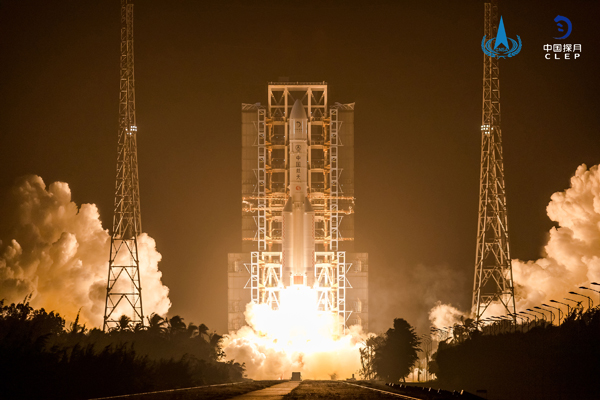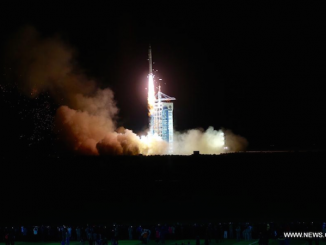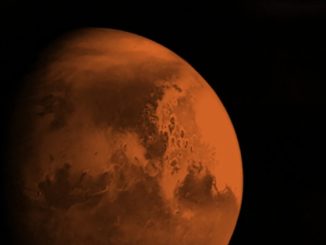
A heavy-lift Long March 5 rocket hurled a 9-ton Chinese spacecraft toward the moon Monday on a 23-day mission attempting to return lunar samples to Earth for the first time in 44 years.
The nearly 20-story rocket fired off its launch pad at the Wenchang space center on Hainan Island in southern China at 3:30 p.m. EST (2030 GMT) Monday with 2.4 million pounds of thrust from 10 liquid-fueled engines.
The Long March 5 rocket is the most powerful launcher in China’s inventory. The launch of the Chang’e 5 lunar sample return mission was delayed by earlier problems with the Long March 5, including a launch failure in 2017 that grounded Long March 5 flights for more than two years.
The rocket worked flawlessly on the launch of Chang’e 5, which occurred at 4:30 a.m. Beijing time Tuesday.
The rocket shed four kerosene-fueled boosters around three minutes after launch, then jettisoned its 17-foot-diameter (5.2-meter) payload shroud after climbing into space. The Long March 5’s cryogenic core stage, powered by two hydrogen-fed main engines, propelled the Chang’e 5 spacecraft to near orbital velocity.
Twin hydrogen-fueled engines performed two burns to power the 18,000-pound (8.2-metric ton) Chang’e 5 spacecraft on a trajectory toward a point a quarter-million miles from Earth, where it will enter orbit around the moon within a few days.
The exact timeline for the mission has not been released by Chinese officials, but the spacecraft is expected to release a lander to touch down near Mons Rümker, a volcanic formation that extends more than 4,000 feet — or about 1,300 meters — above the surrounding lava plains.
Chang’e 5’s landing site is located in the Oceanus Procellarum, or Ocean of Storms, region in the northern hemisphere of the near side of the moon. The touchdown is expected to occur before the end of November, and the surface mission will occur during a two-week window of daylight at the landing site, allowing solar energy to power the spacecraft.
Once on the moon, Chang’e 5 will extract up to 4.4 pounds, or 2 kilograms, of material from a depth of up to 6.6 feet, or 2 meters, below the surface. Then the specimens will launch back into lunar orbit aboard a small rocket, rendezvous with a return craft, and head for Earth.
The return carrier will re-enter the atmosphere at some 25,000 mph, or 40,000 kilometers per hour, significantly faster than a re-enter from low Earth orbit. The capsule will will land around Dec. 15 in China’s Inner Mongolia region, where teams will retrieve the moon specimens and transport the material to a lab for analysis.

Clive Neal, a lunar scientist at the University of Notre Dame, said China has proven it can land on the moon with previous missions.
“But then they have to collect the sample,” Neal said. “The interesting thing is they launch from the moon, get into lunar orbit, and then rendezvous with the Earth re-entry vehicle that will bring that sample back to Earth safely and uncompromised. When the Soviets did it in 1976, the last time, it was direct to Earth. They launched form the moon and came straight back to Earth. This one has an extra strp in there, which has to go well in order for the sample to actually make it back.
“But given the capability they’ve demonstrated with doing things for the first time, such as the far side landing and roving, I expect things to be successful, and hope they are,” Neal said in an interview with Spaceflight Now.
The sample return mission, if successful, will mark the first time lunar material has been returned to Earth since 1976, when the Soviet Union’s robotic Luna 24 mission brought back around 170 grams, or 6 ounces, of specimens from the lunar surface.
Nine missions have returned moon samples to Earth, including NASA’s six Apollo missions with astronauts, and three robotic Luna spacecraft launched by the Soviet Union. NASA’s Apollo missions brought back 842 pounds (382 kilograms) of rocks from the moon.
There is evidence that rocks in Chang’e 5’s landing zone are much younger than those returned by the Apollo astronauts. Those specimens are some 3.5 billion years old, created during a period of active volcanism in the first billion years of the moon’s existence.
Lava plains to the east of Mons Rümker appear to be less battered by asteroid impacts, suggesting rocks there could be less than 2 billion years old. But models of the moon’s evolution suggest its internal heating should have diminished by that time, rendering volcanoes extinct, Neal said.
“It will be exciting to look at the age of these samples coming back and also the actual compositions of them,” Neal said.
“China is doing a great job here in terms of their first sample return mission,” said James Head, a planetary scientist at Brown University, during remarks broadcast on Chinese state television. “We haven’t been returning samples for 44 years, and we have many scientific questions which the Chang’e 5 mission is going to help us answer. This is really exciting opportunity, and we really appreciate China’s efforts in this area.”
Before Chang’e 5, China has successfully dispatched four robotic explorers to the moon, beginning with the Chang’e 1 and Chang’e 2 orbiters in 2007 and 2010. In 2013, China landed the Chang’e 3 mission on the moon with a mobile rover that drove across the lunar surface.
China’s most challenging lunar mission to date was Chang’e 4, which accomplished the first-ever soft landing on the far side of the moon in January 2019. Chang’e 4’s rover continues operating, sending back imagery and scientific data through a dedicated relay satellite China placed in a position beyond far side of the moon to transmit signals between Earth and the Chang’e 4 spacecraft.

The Chang’e missions are named for a moon goddess in Chinese folklore.
China has a backup to the Chang’e 5 spacecraft named Chang’e 6. If Chang’e 5 is successful, Chang’e 6 could attempt a sample return mission from the far side of the moon.
Unlike Chang’e 5, which is an all-Chinese mission, the Chang’e 6 spacecraft will carry foreign instruments to the lunar surface. The French space agency, CNES, announced last year that it will provide an instrument for the Chang’e 6 mission to study the moon’s exosphere and water cycle.
China is also planning a robotic station on the moon’s south pole before a possible landing on the moon with Chinese astronauts in the 2030s.
Chinese officials have signaled they are open to partnering with other countries on lunar exploration. Instruments developed by scientists in Sweden, Germany, and Saudi Arabia have flown to the moon on past Chinese mission.
The European Space Agency said it provided tracking support during the initial phases of the Chang’e 5 mission after launch Monday, and will offer similar communications relay support during the spacecraft’s return to Earth next month.
NASA is legally barred from any cooperation with China on space exploration projects.
“With Chang’e 5, China has launched an effort to join the U.S. and the former Soviet Union in obtaining lunar samples,” NASA said in a statement posted on Twitter. “We hope China shares its data with the global scientific community to enhance our understanding of the moon like our Apollo missions did and the Artemis program will.”
NASA’s Artemis program aims to return astronauts to the lunar surface in the 2020s.
Neal said he would be surprised if the Chang’e 5 samples are distributed outside of China, at least initially.
“I don’t expect them to come to the U.S. given the souring of relations between China and the U.S. at the political level,” Neal said. “However, I think there will be potential collaborations between scientists. The lunar science community is international in nature, and we tend to get along pretty well. So I’m hoping the results will be made available through our science colleagues, even if the samples can’t come out of China.”
Email the author.
Follow Stephen Clark on Twitter: @StephenClark1.



